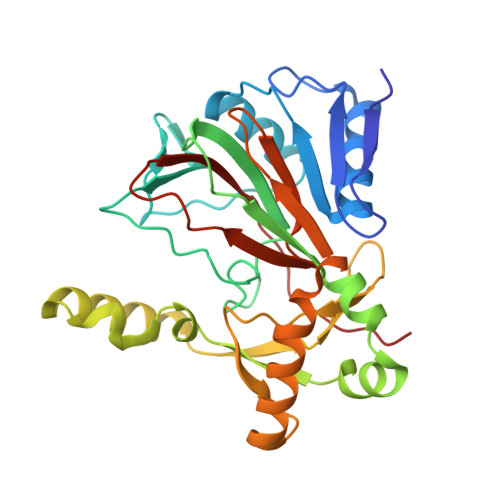Structure of a Ferryl Mimic in the Archetypal Iron(II)- and 2-(Oxo)-glutarate-Dependent Dioxygenase, TauD.
Davis, K.M., Altmyer, M., Martinie, R.J., Schaperdoth, I., Krebs, C., Bollinger Jr., J.M., Boal, A.K.(2019) Biochemistry 58: 4218-4223
- PubMed: 31503454
- DOI: https://doi.org/10.1021/acs.biochem.9b00598
- Primary Citation of Related Structures:
6EDH - PubMed Abstract:
Iron(II)- and 2-(oxo)-glutarate-dependent (Fe/2OG) oxygenases catalyze a diverse array of oxidation reactions via a common iron(IV)-oxo (ferryl) intermediate. Although the intermediate has been characterized spectroscopically, its short lifetime has precluded crystallograhic characterization. In solution, the ferryl was first observed directly in the archetypal Fe/2OG hydroxylase, taurine:2OG dioxygenase (TauD). Here, we substitute the iron cofactor of TauD with the stable vanadium(IV)-oxo (vanadyl) ion to obtain crystal structures mimicking the key ferryl complex. Intriguingly, whereas the structure of the TauD·(V IV -oxo)·succinate·taurine complex exhibits the expected orientation of the V≡O bond- trans to the His255 ligand and toward the C-H bond to be cleaved, in what has been termed the in-line configuration-the TauD·(V IV -oxo) binary complex is best modeled with its oxo ligand trans to Asp101. This off-line-like configuration is similar to one recently posited as a means to avoid hydroxylation in Fe/2OG enzymes that direct other outcomes, though neither has been visualized in an Fe/2OG structure to date. Whereas an off-line ( trans to the proximal His) or off-line-like ( trans to the carboxylate ligand) ferryl is unlikely to be important in the hydroxylation reaction of TauD, the observation that the ferryl may deviate from an in-line orientation in the absence of the primary substrate may explain the enzyme's mysterious self-hydroxylation behavior, should the oxo ligand lie trans to His99. This finding reinforces the potential for analogous functional off-line oxo configurations in halogenases, desaturases, and/or cyclases.





















